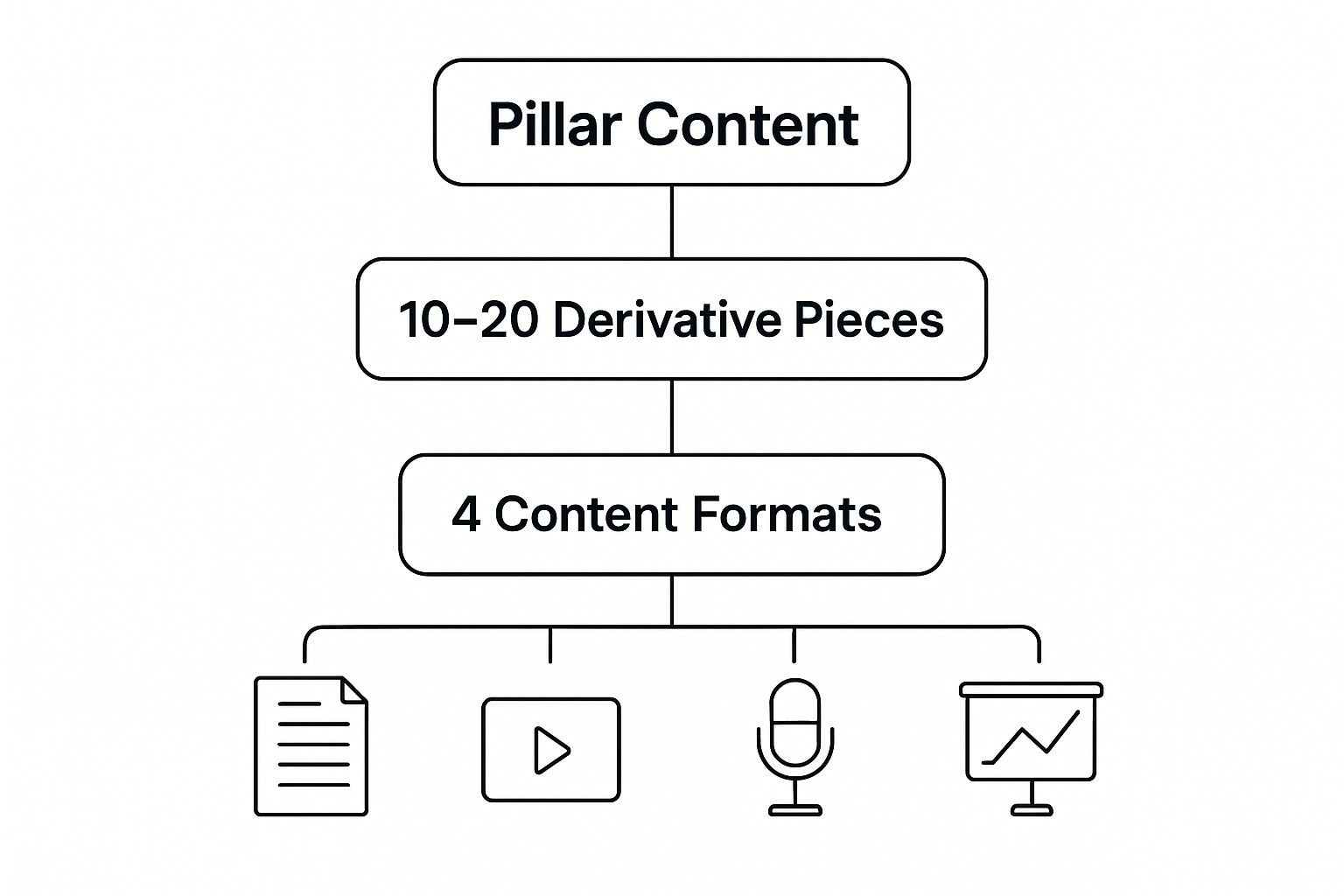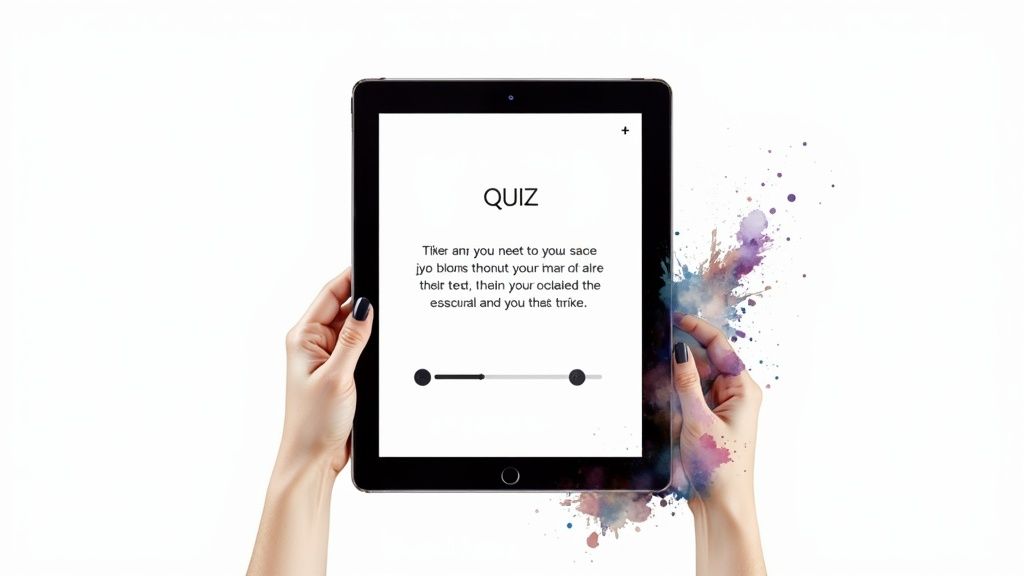Top Content Repurposing Strategies to Boost Your Reach in 2025

Unlock Your Content's Hidden Potential
Imagine creating a single piece of content and seeing it ripple across the internet, capturing attention on every major platform. This isn't about working harder; it's about working smarter. Effective content marketing demands more than just creation, it requires strategic multiplication. The primary challenge for modern creators, solopreneurs, and marketing agencies isn't a lack of ideas, but a lack of time and resources.
How can you maintain a constant, high-quality presence on Twitter, LinkedIn, Instagram, and your blog without burning out? The answer lies in mastering content repurposing strategies. By strategically transforming your high-value assets into a diverse arsenal of content formats, you can amplify your reach, reinforce your message, and engage different audience segments where they spend their time.
This guide moves beyond generic advice like 'turn a blog post into a tweet.' We will dive deep into nine distinct, actionable frameworks. From the comprehensive Pillar Content Method to advanced Interactive Content Transformation, you will get specific blueprints to maximize the value from your hard work. This approach helps you build a content ecosystem that works for you around the clock, ensuring every effort delivers exponential returns.
1. The Pillar Content Method: Building Your Content Kingdom
The Pillar Content Method is one of the most powerful content repurposing strategies because it establishes a structured content ecosystem, not just a series of one-off posts. The core idea is to create a single, substantial piece of content, the "pillar," which is then strategically deconstructed into smaller, derivative pieces of "cluster content" for various platforms. This approach maximizes the return on your initial high-effort content investment.
Think of it this way: instead of creating 20 separate pieces of content from scratch, you invest deeply in one comprehensive guide, a long-form video, or an in-depth research report. This pillar then becomes the single source of truth that fuels your entire content calendar. For instance, a 5,000-word "Ultimate Guide to DeFi" could be atomized into a ten-part email course, multiple blog posts on specific DeFi protocols, a YouTube tutorial explaining yield farming, and dozens of Twitter threads and Instagram infographics highlighting key concepts.
How to Implement the Pillar Content Method
- Start with an Evergreen Pillar: Choose a topic with long-term relevance to your audience. This ensures your core asset continues to generate value and traffic for months or even years.
- Map Your Content Clusters: Before you begin writing, create a mind map or spreadsheet. List your pillar topic in the center and branch out with every possible derivative piece. Plan the format (e.g., video, carousel, blog post) and platform for each one.
- Vary the Hook and Angle: Each cluster piece should stand on its own. While the core information is the same, tailor the hook, title, and introduction to the specific platform and audience segment you're targeting. For example, a LinkedIn post might focus on the business application, while an Instagram reel might highlight a surprising statistic.
This hierarchical structure visualizes how a single pillar can be broken down into numerous derivative pieces across different formats.

As the diagram illustrates, the method is built on a foundation of one-to-many, where a single high-value asset is efficiently multiplied.
2. Cross-Platform Format Transformation: Adapting Your Message for Every Medium
Cross-Platform Format Transformation is one of the most direct content repurposing strategies, focusing on the systematic conversion of a core message into various formats tailored for different platforms. Unlike the Pillar Method, which deconstructs a large asset, this strategy adapts a single idea or finished piece into entirely new media types. It's about maintaining the essence of your message while completely re-imagining its delivery to fit the unique culture and technical specifications of each channel.
The goal is to meet your audience where they are, in the format they prefer. For example, a data-rich blog post can be transformed into a visually engaging Instagram carousel that highlights key statistics. That same post's core arguments could then become the script for a YouTube video, a discussion topic for a podcast episode, or a concise, professional thread on Twitter. This approach, popularized by marketers like Neil Patel, ensures your valuable insights reach the widest possible audience by speaking each platform's native language.
How to Implement Cross-Platform Format Transformation
- Study Platform-Specific Nuances: Don't just copy and paste. Analyze the optimal format for each platform. What are the ideal image dimensions for an Instagram Story? What is the average video length that performs well on LinkedIn? Understanding these technical and cultural rules is crucial for success.
- Adapt Tone and Style: Your professional tone on LinkedIn should be different from your more casual, visual-first approach on Instagram. Adjust your language, use of emojis, and overall style to match the expectations of each platform's user base.
- Create Tailored Calls-to-Action (CTAs): A CTA that works in a blog post (e.g., "Download our eBook") won't work in a TikTok video. Adapt your CTA to the platform's capabilities, such as using "Link in bio" on Instagram, "Swipe up" on Stories, or asking for a "Retweet" on Twitter.
3. Micro-Content Atomization: Winning the Attention Economy
Micro-Content Atomization is one of the most effective content repurposing strategies for today's fast-paced digital environment. This technique involves deconstructing a single, long-form content asset, such as a webinar or a comprehensive article, into numerous standalone, bite-sized pieces. Each micro-piece is designed to deliver a specific, high-impact insight in seconds, catering to the short attention spans prevalent on social media platforms.

This approach, popularized by figures like Gary Vaynerchuk, isn't just about slicing up content; it's about identifying the most potent "nuggets" of value. For example, a one-hour podcast interview can be atomized into dozens of assets: ten quote cards for Instagram, five 30-second video clips for TikTok and Reels, a multi-slide carousel for LinkedIn summarizing key takeaways, and a long Twitter thread detailing a powerful story told by the guest. This strategy allows you to dominate multiple platforms and create numerous touchpoints from a single content creation effort.
How to Implement Micro-Content Atomization
- Identify High-Impact Moments: During or after creating your long-form content, actively look for "Aha!" moments. These are quotable statements, surprising statistics, compelling anecdotes, or actionable tips that can stand alone and provide immediate value.
- Design for the Platform: Each micro-piece must be visually native to its intended platform. A quote that works as a simple text tweet needs to be placed on a branded, visually appealing template to work as an Instagram post. A vertical video clip for Reels will require different editing and captions than a wide-format clip for YouTube.
- Track and Optimize: Not all micro-content will resonate equally. Pay close attention to your analytics. A particular style of quote card or type of video clip might consistently outperform others. Use this data to inform what kind of moments you extract and how you package them in the future.
4. Sequential Content Series Development: Hooking Your Audience
Sequential Content Series Development is one of the most engaging content repurposing strategies because it transforms a single, large piece of content into a connected, episodic journey for your audience. The core principle is to break down a comprehensive resource, like a research report or an online course, into smaller, sequential parts that build on one another. This method fosters anticipation and keeps your audience coming back for the next installment, turning passive consumption into active participation.
Imagine you have a detailed book or an extensive training manual. Instead of publishing it as a single, intimidating asset, you can serialize it. For example, a book chapter on marketing funnels could become a five-part podcast series, with each episode exploring a different stage of the funnel. Similarly, a comprehensive video tutorial could be repurposed into a weekly YouTube series, with each video teaching one specific skill, creating a habit of viewership and deep engagement with your brand.
How to Implement a Sequential Content Series
- Create Compelling Cliffhangers: End each installment with a hook or an open loop that teases the content of the next episode. This creates a strong incentive for your audience to return and complete the series, dramatically increasing long-term engagement.
- Maintain a Consistent Schedule: Reliability is key. Whether you publish daily, weekly, or bi-weekly, stick to a predictable schedule. This trains your audience to anticipate your content and builds a loyal following around the series.
- Ensure Each Piece Adds Value: While part of a larger whole, each individual piece must offer standalone value. A viewer or reader should gain a specific insight or learn a useful tip from every single installment, even if they miss others.
- Cross-Reference and Interlink: Actively connect the pieces in your series. Mention previous episodes and preview upcoming ones to reinforce the narrative and guide your audience through the entire sequence. This is also a great way to guide users through a social media funnel.
This video provides a deep dive into creating content that builds a narrative and keeps viewers engaged.
By structuring your content this way, you maximize its educational impact and transform a single asset into a powerful audience-building machine.
5. User-Generated Content Integration: Turning Audience into Assets
User-Generated Content (UGC) Integration is a dynamic repurposing strategy that transforms audience engagement into valuable new content. Instead of solely relying on your own ideas, this method involves actively collecting, curating, and featuring audience questions, comments, feedback, and submissions. This is one of the most effective content repurposing strategies for building a strong, interactive community around your brand.
The core principle is to treat audience interactions as raw material. A simple question in your Instagram comments can become the topic of a detailed blog post. A collection of frequently asked questions from a webinar can be compiled into a dedicated YouTube Q&A video. For example, business coach Tim Ferriss frequently records podcast episodes dedicated entirely to answering listener questions, while fitness influencers often feature user-submitted progress photos or workout videos. This approach not only provides an endless stream of relevant content ideas but also makes your audience feel seen, heard, and valued.
How to Implement User-Generated Content Integration
- Actively Solicit Contributions: Don't just wait for comments to roll in. Use features like Instagram's "Questions" sticker, run polls on Twitter, or create dedicated threads in community forums asking for feedback and queries. Make it clear that their input could be featured.
- Curate and Credit: Sift through submissions to find the highest-quality or most common questions. When you feature someone's content or question, always give them credit by tagging their social media handle or mentioning their name. This encourages more participation in the future.
- Systematize Your Collection: Create a simple system, like a spreadsheet or a dedicated Slack channel, to save interesting comments, questions, and user content as you see them. This creates a repository you can pull from whenever you need fresh content, turning reactive engagement into a proactive content engine. This can also be an excellent source for social media lead generation. To explore this topic further, you can learn more about social media lead generation on growchief.com.
6. Temporal Content Recycling: Breathing New Life into Past Successes
Temporal Content Recycling is a clever strategy focused on strategically reviving and updating your older content. Instead of letting high-performing assets gather dust, this approach involves refreshing them with new information, data, or perspectives, then re-launching them to capture the attention of your current audience. This is one of the most efficient content repurposing strategies because it leverages proven winners from your content library.
Think of it as a strategic "throwback" with a modern twist. You aren't just reposting old work; you're enhancing its value. For instance, a popular 2022 blog post, "The Top 5 Crypto Wallets," can be updated for the current year as "The Top 5 Crypto Wallets for [Current Year]: A Revised Guide." Similarly, you can compile your best-performing articles, videos, and social media posts from the past year into an annual "Best Of" roundup, giving new followers a curated look at your greatest hits while re-engaging your existing audience.
How to Implement Temporal Content Recycling
- Audit Your Analytics: Begin by identifying your all-time best-performing content. Look for posts with high traffic, strong engagement, or significant conversion rates. These are your prime candidates for recycling.
- Update and Enhance: The key is to add genuine value, not just change the date. Add new statistics, replace outdated examples, include fresh insights, or update screenshots and visuals. Clearly label the content as "updated" to be transparent with your audience.
- Repackage for a New Context: Don't just update the content; re-promote it with a fresh angle. A "throwback" social media post can frame an old article with new commentary. An updated infographic with current data can be shared as an entirely new visual asset.
7. The Multi-Angle Perspective Approach: Serving Every Segment
The Multi-Angle Perspective Approach is one of the most audience-centric content repurposing strategies available. Instead of deconstructing content by format, this method involves taking a single core topic and re-examining it through the lens of different audience segments, industries, or user proficiency levels. This creates a suite of highly targeted assets that resonate more deeply with specific subsets of your audience.
This strategy acknowledges that a one-size-fits-all message rarely works. A single piece of advice, like "How to Improve Team Productivity," has vastly different implications for a healthcare administrator versus a tech startup founder. By creating separate, tailored pieces for each persona, you demonstrate a nuanced understanding of their unique challenges and goals. For example, a financial advisor's core advice on investing can be repurposed into distinct articles for recent graduates, mid-career professionals, and pre-retirees, each using relevant examples and addressing different life-stage concerns.
How to Implement the Multi-Angle Perspective Approach
- Identify Your Audience Segments: Start by mapping out all the distinct personas or user groups within your total audience. Consider their industry, experience level (beginner, intermediate, advanced), role, or specific goals (e.g., weight loss vs. muscle gain).
- Create Persona-Specific Angles: For a single core topic, brainstorm the unique questions, pain points, and applications relevant to each segment. A product tutorial could be split into a "Beginner's Quick Start Guide" and an "Advanced Power-User Tricks" video.
- Tailor Examples and Case Studies: Maintain the core principles of your content but swap out the evidence. Use industry-specific case studies, role-relevant examples, and terminology that speaks directly to each audience. A leadership guide for retail might discuss floor management, while the tech version focuses on agile development teams.
8. Interactive Content Transformation
Interactive Content Transformation is one of the most engaging content repurposing strategies because it converts passive readers into active participants. This method involves taking static content, such as a blog post or a data report, and rebuilding it into an interactive format like a quiz, calculator, or poll. By doing so, you dramatically increase user engagement, data collection opportunities, and content memorability.

Instead of just presenting information, you create a two-way street that provides immediate, personalized value. For example, a detailed blog post on "Choosing the Right Crypto Wallet" can be repurposed into a "Which Crypto Wallet is Best for You?" quiz. The user answers a few questions about their needs and receives a tailored recommendation, transforming a generic guide into a personalized consultation. This active participation makes the information more impactful and drives deeper brand connection, which is a key component of effective social media community management.
How to Implement Interactive Content Transformation
- Identify Interactive Potential: Review your top-performing static content. Look for educational posts that can become quizzes, data-heavy reports that can become interactive infographics, or how-to guides that can be turned into simple calculators or assessment tools.
- Focus on Immediate Value: The interaction must provide a clear benefit to the user. This could be a personalized result, a score, a customized recommendation, or access to exclusive insights. The payoff should be instant and relevant.
- Keep it Simple and Intuitive: The user interface should be clean and the process straightforward. Avoid complex questions or a lengthy series of steps that might cause users to abandon the experience before they finish.
- Leverage the Results: Use the data collected from your interactive content to understand your audience better. The quiz results or poll answers can become the foundation for new, highly targeted follow-up content.
9. Educational Content Laddering: Guiding Your Audience to Mastery
Educational Content Laddering is a structured approach that transforms a single, complex educational topic into a progressive learning journey. This method involves deconstructing an advanced subject into distinct levels of difficulty, creating a "ladder" of content that guides your audience from foundational knowledge to expert-level mastery. This is one of the most effective content repurposing strategies for establishing authority and nurturing a loyal, skilled audience.
Instead of creating one massive, intimidating guide that might alienate beginners, you segment it into accessible stages. For example, a comprehensive masterclass on "Crypto Trading" could be broken down into a "101: Intro to Cryptocurrency" blog post series, a "201: Technical Analysis for Beginners" video tutorial, and a "301: Advanced Options Strategies" webinar. Each piece builds on the last, creating a clear and rewarding learning path that keeps your audience engaged and motivated to continue their journey with your brand.
How to Implement Educational Content Laddering
- Define Clear Learning Objectives: For each "rung" on your ladder (e.g., beginner, intermediate, advanced), establish what the audience member should know or be able to do by the end. This ensures each piece has a distinct purpose and delivers tangible value.
- Create Seamless Transitions: Actively guide users to the next level. End your beginner content with a clear call-to-action that introduces the intermediate material. For instance, conclude a "Basic SEO Keywords" article with a link to your "Guide to On-Page SEO Implementation."
- Maintain Consistent Frameworks: Use the same terminology, visual branding, and core concepts across all levels. This consistency reinforces learning and makes the progression feel like a cohesive, unified course rather than a collection of random tips. This strategy builds trust and positions you as a reliable educator.
Content Repurposing Strategies Comparison
| Method | Implementation Complexity 🔄 | Resource Requirements ⚡ | Expected Outcomes 📊 | Ideal Use Cases 💡 | Key Advantages ⭐ |
|---|---|---|---|---|---|
| The Pillar Content Method | High: significant upfront investment | Moderate: content creation and repurposing | Strong topical authority and consistent messaging | Evergreen topics, building content ecosystems | Maximizes ROI, consistent brand, deep topic coverage |
| Cross-Platform Format Transformation | Moderate to high: platform-specific adaptation | Moderate to high: requires platform expertise | Broad multi-channel reach and optimized engagement | Multi-platform campaigns, audience diversification | Increases reach and visibility, platform optimization |
| Micro-Content Atomization | Moderate: breaking down and curating many pieces | Moderate: design and rapid deployment | High volume content, increased social engagement | Social media, short attention spans content | Quick volume, frequent posting, high engagement |
| Sequential Content Series Development | High: strong planning and scheduling | Moderate to high: organized production | Improved retention, ongoing audience engagement | Educational content, storytelling, building anticipation | Builds loyalty, natural calendar structure |
| User-Generated Content Integration | Moderate: requires active community management | Low to moderate: leveraging audience content | Enhanced community engagement and authentic content | Communities, Q&A formats, feedback-driven content | Builds community, reduces content burden |
| Temporal Content Recycling | Low to moderate: updating existing content | Low to moderate: research and refresh | Extended content lifespan, improved SEO | Evergreen content, outdated resources refresh | Saves time, maximizes past investments |
| Multi-Angle Perspective Approach | Moderate: requires deep topic segmentation | Moderate: tailored content per audience | Broader appeal across segments, thought leadership | Diverse audiences, complex topics with varied interests | Appeals to segments, maximizes topic exploitation |
| Interactive Content Transformation | High: technical creation and maintenance | High: development and design resources | Dramatically increased engagement and participation | Engagement-focused marketing, education, data collection | High engagement, audience insights, memorable experience |
| Educational Content Laddering | High: extensive expertise and layered design | High: subject matter experts and production | Progressive learning, authority building | Education platforms, skill development, long-term programs | Supports all levels, upselling opportunities |
Systemize Your Strategy and Automate Your Growth
We've explored nine powerful content repurposing strategies, moving far beyond simply reposting an old article. From the foundational Pillar Content Method to the innovative Educational Content Laddering, each approach offers a distinct pathway to multiply the value of your creative efforts. The journey from a single blog post to a series of engaging tweets, an insightful infographic, a dynamic video, and an interactive quiz is no longer a complex maze. It is a clear, systematic process.
The core lesson is this: effective content marketing is not about creating more; it's about making more of what you create. By viewing each piece of content as a source asset, you unlock a treasure trove of potential. Atomizing a detailed guide into micro-content for social media, transforming data into a visual story, or recycling temporal content with fresh insights are all ways to build a ubiquitous brand presence without burning out. These content repurposing strategies are your toolkit for achieving maximum impact with calculated effort.
From Ad-Hoc Tactics to a Sustainable System
The true power of these concepts is realized when you move from sporadic repurposing to building a repeatable system. Your content workflow should not end at "publish." Instead, "publish" should be the starting pistol for a series of planned repurposing and distribution activities.
Here are your actionable next steps to operationalize these strategies:
- Conduct a Content Audit: Begin by reviewing your existing content library. Identify your high-performing "pillar" articles, videos, or podcasts. These are your most valuable assets and the perfect starting point.
- Create a Repurposing Matrix: Map out your chosen pillar content against the strategies we've discussed. For a single pillar post, you could plan to create 10 micro-content tweets (Atomization), a 3-part email series (Sequential Development), and one infographic (Format Transformation).
- Integrate into Your Calendar: Schedule these repurposing tasks directly into your content calendar. Treat them with the same importance as new content creation. This ensures consistency and turns your strategy into a habit.
Amplify Your Reach, Automate Your Engagement
Mastering these content repurposing strategies will ensure you have a constant stream of high-quality material to share across all your platforms. However, creation and distribution are only two parts of the equation. True growth happens when that content sparks conversations and builds relationships, a task that can be incredibly time-consuming. This is where automation becomes a strategic advantage, not just a time-saver. By automating engagement, you ensure your repurposed content consistently finds its audience and generates interaction, keeping your brand top-of-mind and actively building a community around your expertise.
By combining an intelligent system for repurposing with smart automation for engagement, you create a self-sustaining growth engine. You'll spend less time on the content treadmill and more time capitalizing on the opportunities your content creates. This is how you build an authoritative brand that not only speaks to its niche but truly dominates the conversation.
Ready to put your repurposed content to work and automate your audience growth? GrowChief acts as your AI-powered engagement agent, finding relevant conversations across social media and interacting on your behalf to drive visibility, replies, and DMs. Stop just posting content and start building relationships at scale.






